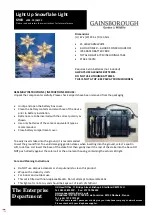
Instruction Manual
IB-106-340 Rev. 3.0
December 2003
Rosemount Analytical Inc. A Division of Emerson Process Management
Installation 2-15
Oxymitter 4000
2. Remove screw (32, Figure 9-4), gasket
(33), and cover lock (34) at the probe
head. Remove housing cover (27).
3. Connect the heater power leads, the
thermocouple leads and the oxygen
signal leads at the terminal block. The
leads are tagged for polarity.
2-4
ELECTRICAL INSTALLATION (FOR
OXYMITTER 4000 WITH SPS 4000)
All wiring must conform to local and national
codes.
Disconnect and lock out power before
connecting the unit to the power
supply.
Install all protective equipment covers
and safety ground leads after installa-
tion. Failure to install covers and
ground leads could result in serious
injury or death.
To meet the Safety Requirements of
IEC 1010 (EC requirement), and ensure
safe operation of this equipment, con-
nection to the main electrical power
supply must be made through a circuit
breaker (min 10 A) which will discon-
nect all current-carrying conductors
during a fault situation. This circuit
breaker should also include a me-
chanically operated isolating switch. If
not, then another external means of
disconnecting the supply from the
equipment should be located close by.
Circuit breakers or switches must
comply with a recognized standard
such as IEC 947.
Autocalibration systems will inject gases into the
probe and make electronic adjustments with no
operator attention required. The SPS 4000 pro-
vides solenoid valves and circuitry for calibrating
a single Oxymitter 4000 unit.
The SPS 4000 autocalibration system utilizes
the Oxymitter 4000’s bidirectional logic contact
as a “handshake” signal. Therefore, this signal
is not available for alarming purposes.
The following contacts are provided through the
autocalibration system:
a.
One contact closure per probe from the con-
trol room to the SPS 4000 for “calibration ini-
tiate”.
b.
One contact output per probe from the SPS
4000 to the control room for “in calibration”
notification.
c.
One contact per probe from the SPS 4000 to
the control room for “calibration failed” notifi-
cation, which includes output from pressure
switch indicating “cal gas bottles empty”.
NOTE
The 4-20 mA signal can be configured
to respond normally during any cali-
bration, or can be configured to hold
the last O
2
value upon the initiation of
calibration. Factory default is for the
4-20 mA signal to operate normally
throughout calibration. Holding the
last O
2
value may be useful if several
probes are being averaged for the
purpose of automatic control. Unless
several probes are being averaged,
always place any control loops using
the O
2
signal into manual prior to
calibrating.
Electrically connect the probe as follows:
d.
Remove screws (26, Figure 9-13) securing
terminal cover (27). Remove the cover to ex-
pose terminal strip (25).
















































